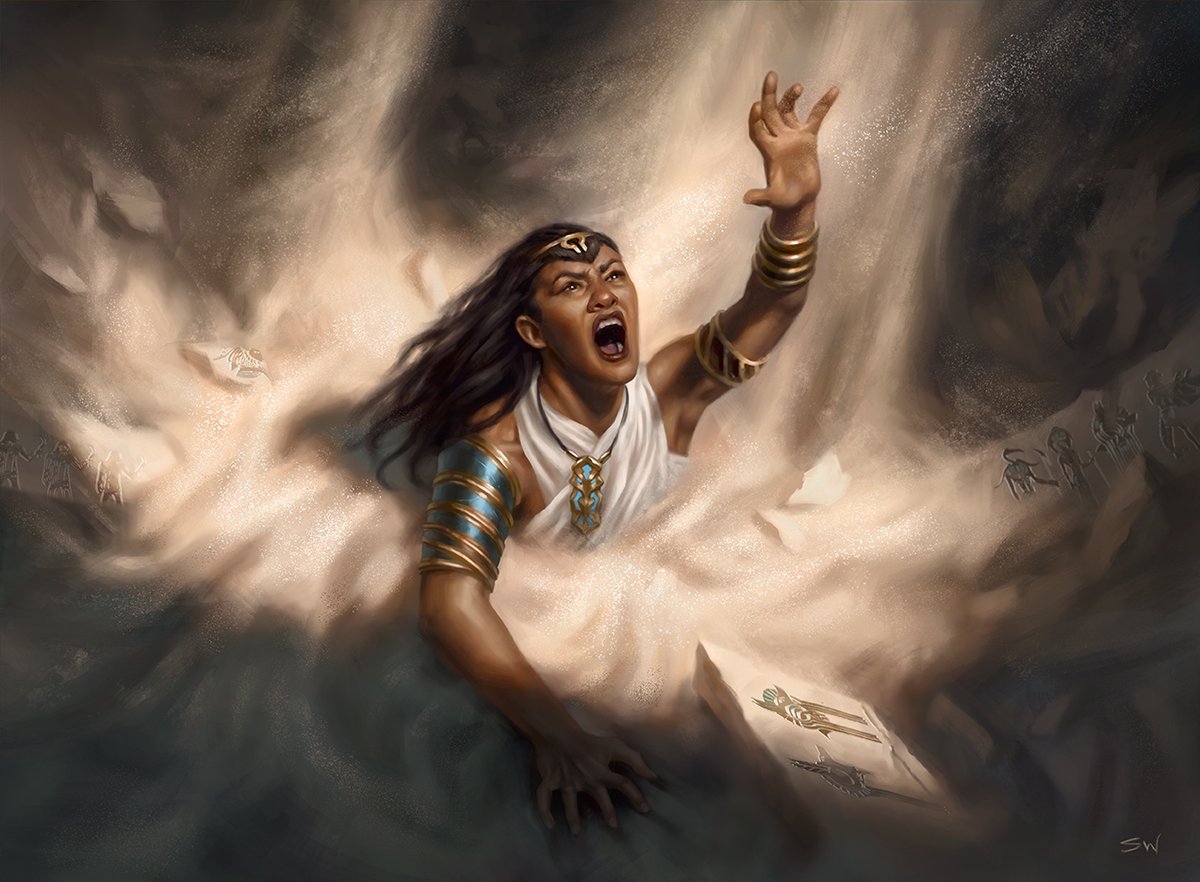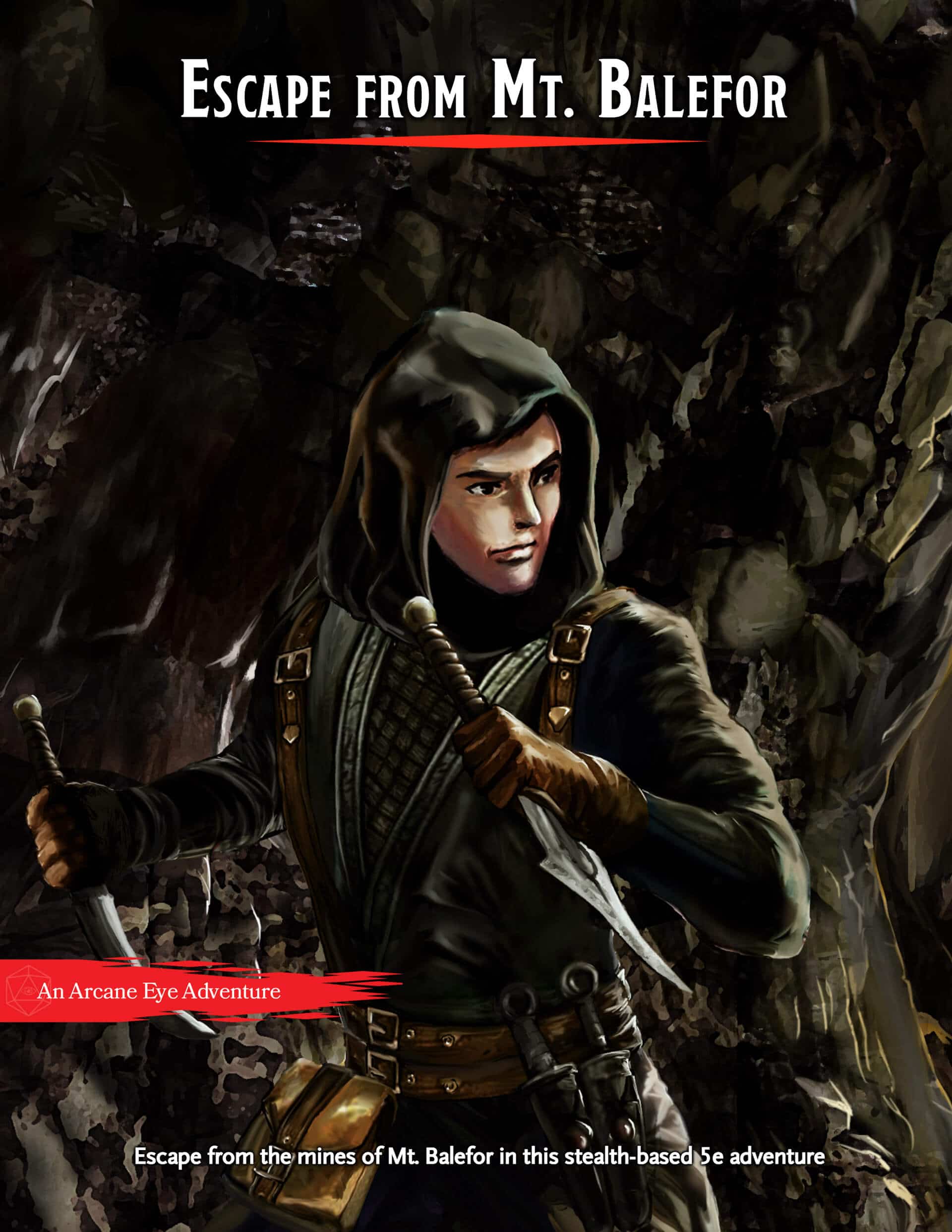Restrained 5e
Published on June 7, 2023, Last modified on December 27th, 2023
Discover the mechanics and implications of the restrained condition in D&D 5e. Explore spells, monster abilities, and tactical uses for this ubiquitous condition in combat.

Sara Winters - Wizards of the Coast - Desert’s Hold
Table of Contents
Restrained in D&D
The restrained condition is an effective option for players and DMs as it’s more potent than being grappled but it can be invoked by mundane means. Not only does restraining a creature make them unable to move, but it also hampers their offensive capabilities and makes them an easier target to hit. This, combined with some strategic play, can make even the toughest enemies in 5e easier to deal with.
Let’s jump into what the restrained condition does and how to use it in your game.
What is the Restrained Condition?
According to the Basic Rules, the restrained condition has the following effects:
Restrained
- A restrained creature’s speed becomes 0, and it can’t benefit from any bonus to its speed.
- Attack rolls against the creature have advantage, and the creature’s attack rolls have disadvantage.
- The creature has disadvantage on Dexterity saving throws.
This condition represents limitations on a creature’s movement, preventing them from moving from their current location, hampering their attacks, and opening them up to attacks from their enemies. Let’s break this down:
The first effect essentially locks you down and prevents you from moving until you’ve broken the restraints. This can be deadly if you’re surrounded by enemies, especially because of the second effect.
Your enemies having advantage on attacks against you is never a good thing. Especially when you’re unable to move and your attacks against them have disadvantage. This is a martial character’s worst nightmare.
Having disadvantage on Dexterity saving throws makes this a very combo-able condition. When you have access to spells low-level AoE restrain effects like web or entangle you can drop this on a crowd to prevent them moving. Then, your wizard friend can fry them all with a fireball that will hit extra hard because they all have disadvantage on the DEX save. Pretty nasty stuff.
Important Things to Note About the Restrained Condition
Can You Attack While Restrained?
Yes, though you will have disadvantage on your attacks until you are released from whatever is restraining you.
Can You Cast Spells While Restrained?
Yes. There is nothing in the rules that says the restrained condition prevents a spellcasters from utilizing somatic components. Thus, they will be able to cast spells normally. One thing to note is that you’ll have disadvantage on spell attacks, like fire bolt or shocking grasp. But, seeing as there’s not disadvantage mechanic for spells that invoke a saving throw, like burning hands, those can be cast without issue.
Can You Stand Up While Restrained?
Much like the grappled condition, if you’re restrained while prone, you’re in a tough spot. Seeing as your movement speed drops to 0, you can’t spend the necessary movement to stand up, meaning you’ll be stuck prone until you can end the condition.
Ways to Cause the Restrained Condition
Players can restrain their targets in a couple ways with mundane or magical means:
Feats
- Grappler: This feat not only provides advantage on Athletic checks made to grapple a creature, but it also enables you to attempt to restrain a creature grappled by you. You can do so by succeeding in a second grapple check as an action, on top of your first successful one.
Items
- Net: The net is a largely overlooked weapon in 5e due to it’s many shortfalls, but it is also the only non-magical item that allows you to impose the restrained condition on a creature.
- Rope: While the description for hempen rope doesn’t explicitly say that you can restrain a creature with it, it does say that a creature can “break out” by succeeding in a DC 17 Strength (Athletics) check. This would imply that tying up a creature with hempen rope would impose the restrained condition with a escape DC of 17.
- Magical Items: There are tons of magical items that impose the restrained condition. Among them are the rope of entanglement, Iron Bands of Binding, and the wand of viscid globs.
Spells
1st Level Spells:
- Entangle (Druid): Creatures in the area must succeed on a Strength saving throw or be restrained by the entangling plants until the spell ends. A creature restrained by the plants can use its action to attempt to break free.
- Ensnaring Strike (Ranger): A successful hit with this spell causes the target to be restrained by magical vines until the spell ends. The restrained creature takes additional damage and can attempt a Strength check to escape.
- Snare (Artificer, Druid, Ranger, Wizard): When triggered, the spell creates a trap that restrains creatures within its area. The restrained creature can attempt a Dexterity saving throw to end the effect. The snare can also be disarmed with an Intelligence (Arcana).
2nd Level Spells:
- Maximilian’s Earthen Grasp (Sorcerer, Wizard): The target must make a Strength saving throw. On a failed save, the target takes 2d6 bludgeoning damage and is restrained for the spell’s duration. As an action, you can cause the hand to crush the restrained target, who must make a Strength saving throw. It takes 2d6 bludgeoning damage on a failed save, or half as much damage on a successful one. To break out, the restrained target can attempt a Strength saving throw.
- Web (Artificer, Sorcerer, Wizard): Creatures caught in the webs must make a Strength check against your spell save DC. If they fail, they are restrained until they succeed on the Strength check or the webs are destroyed. The webs are flammable and can be burned away with fire.
4th Level Spells:
- Evard’s Black Tentacles (Wizard): Creatures in the affected area must succeed on a Dexterity saving throw or take 3d6 bludgeoning damage and be restrained by the tentacles until the spell ends. A creature restrained by the tentacles can use its action to make a Strength or Dexterity check against your spell save DC. On a success, it frees itself.
- Watery Sphere (Druid, Sorcerer, Wizard): Targets who fail the saving throw against this spell are restrained within the sphere until they succeed on the saving throw or the spell ends. The restrained creature can repeat the saving throw at the end of each of its turns.
5th Level Spells:
- Transmute Rock (Artificer, Druid, Wizard): Both of the effects of this spell can restrain a creature, with the Transmute Mud to Rock option providing a higher DC for escape.
- Wrath of Nature (Druid, Ranger): The Roots and Vines option can restrain one creature of your choice within the cube, forcing it to succeed on a Strength saving throw or remain restrained until the spell ends.
6th Level Spells:
- Bones of the Earth (Druid): Pillars of stone erupt from the ground, potentially restraining creatures that get caught between them and another object. A restrained creature can attempt a Strength or Dexterity check to break free.
- Flesh to Stone (Warlock, Wizard): Creatures that fail the saving throw against this spell are restrained as their flesh begins to harden. If they continue to fail their saving throws, they get turned to stone and petrified.
7th Level Spells:
- Prismatic Spray (Sorcerer, Wizard): The Indigo option applies the same effect as flesh to stone; restraining foes and eventually petrifying them.
- Whirlwind (Druid, Sorcerer, Wizard): Creatures caught in the whirlwind must succeed on a Strength saving throw or become restrained until the spell ends. A restrained creature moves with the whirlwind.
9th Level Spells:
- Imprisonment (Warlock, Wizard): You can use the Chaining option of this spell to restrain a creature without a saving throw. Seeing as the duration of this spell is “until dispelled” this can result in a perpetual application of this condition.
- Prismatic Wall (Wizard): Creatures that fail saving throws against this spell’s Indigo prismatic colors are afflicted in the same was as the prismatic spray spell.
- Ravenous Void (Graviturgy Magic): A creature that enters the sphere or starts its turn there takes damage and becomes restrained until it is no longer in the sphere. They can attempt a Strength check to escape.
Restraining With Monsters
Monsters in D&D 5e can employ various methods to restrain their targets. Some creatures, such as giant spiders, can use their web ability to create sticky webs that trap and restrain their prey, limiting their movement.
Other monsters, like the roper, possess multiple tendrils capable of constricting and restraining opponents during combat, rendering them immobile. These creatures are special instances and can grapple and restrain creatures in the same action, making the restraining of creatures a big part of them game plan.
Additionally, creatures with special abilities or spells, like the aboleth’s Enslave ability or the medusa’s Petrifying Gaze, can inflict the restrained condition through their unique abilities, effectively immobilizing their victims.
Ways to Escape Being Restrained
Much like the grappled condition, there are a couple ways to escape being restrained:
If you find yourself on the wrong side of a grapple, there are a couple ways you can escape unscathed:
- Escape using an ability check: Most restrained effects have an escape DC associated with them. The most straightforward way to break out is to use your action to succeed in this check.
- Teleport out: For the small cost of a bonus action and a 2nd-level spell slot, you can easily misty step out of whatever is restraining you.
- Blast your opponent away: If you’re being restrained by a creature, using a spell like thunderwave can forcibly move your opponent, thereby exceeding their reach and breaking their hold on you.
- Incapacitate your opponent: Your opponent won’t be able to restrain you if they’re unconscious! There are plenty of ways to incapacitate foes, ranging from the sleep spell to a monk’s Stunning Strike!
Restrain Yourself
The restrained condition in D&D 5e is a powerful tool that is relatively common, based on the sheer number of ways to impose the condition. Whether imposed by spells, monster abilities, environmental factors, or a buff barbarian trying to smother their enemies, being restrained can severely limit a creature’s mobility and effectiveness.
Unfortunately, it’s outside of the reach of most martial characters because it’s hidden behind an additional feat that doesn’t provide much value outside of its primary feature. That said, there’s nothing stopping martial characters from carrying rope and tying up their enemies for good measure!
